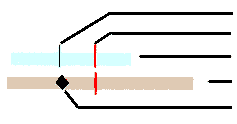The following tables summarize data collected for NAWQA studies from 1992-1995 by showing results for the Georgia-Florida Coastal Plain Study Unit compared to the NAWQA national range for each compound detected. The data were collected at a wide variety of places and times. In order to represent the wide concentration ranges observed among Study Units, logarithmic scales are used to emphasize the general magnitude of concentrations (such as 10, 100, or 1000), rather than the precise number. The complete dataset used to construct these tables is available upon request.
Water samples: Compounds detected || Compounds not detected
Clam tissue and bed sediment samples: Compounds detected || Compounds not detected
[mg/L, milligrams per liter; µg/L, micrograms per liter; pCi/L, picocuries per liter; %, percent; <, less than;--, not measured; trade names may vary]
EXPLANATION
 |
Freshwater-chronic criterion for the protection of aquatic life a
|
|---|
|
|
|
|
|
|
|
|
2,4,5-T
2,4,5-TP
(Silvex, Fenoprop)
Acetochlor
(Harness Plus, Surpass)
Acifluorfen
(Blazer, Tackle 2S)
Bromoxynil
(Buctril, Brominal)
Chloramben
(Amiben, Amilon-WP, Vegiben)
Clopyralid
(Stinger, Lontrel, Reclaim, Transline)
Dacthal mono-acid
(Dacthal metabolite)
Dicamba
(Banvel, Dianat, Scotts Proturf)
Dichlorprop
(2,4-DP, Seritox 50, Kildip, Lentemul)
Dinoseb
(Dinosebe)
MCPA
(Rhomene, Rhonox, Chiptox)
MCPB
(Thistrol)
Neburon
(Neburea, Neburyl, Noruben)
Oryzalin
(Surflan, Dirimal)
Picloram
(Grazon, Tordon)
Propham
(Tuberite)
Triclopyr
(Garlon, Grandstand, Redeem, Remedy)
3-Hydroxycarbofuran
(Carbofuran metabolite)
Aldicarb sulfone
(Standak, aldoxycarb, aldicarb metabolite)
Aldicarb
(Temik, Ambush, Pounce)
Methiocarb
(Slug-Geta, Grandslam, Mesurol)
Methomyl
(Lanox, Lannate, Acinate)
Methyl parathion
(Penncap-M, Folidol-M, Metacide, Bladan M)
Oxamyl
(Vydate L, Pratt)
Propoxur
(Baygon, Blattanex, Unden, Proprotox)
1,1,1,2-Tetrachloroethane
(1,1,1,2-TeCA)
1,1,1-Trichloroethane
(Methylchloroform)
1,1,2,2-Tetrachloroethane
1,1,2-Trichloro-1,2,2-trifluoroethane
(Freon 113, CFC 113)
1,1,2-Trichloroethane
(Vinyl trichloride)
1,1-Dichloroethane
(Ethylidene dichloride)
1,1-Dichloroethene
(Vinylidene chloride)
1,1-Dichloropropene
1,2,3-Trichlorobenzene
(1,2,3-TCB)
1,2,3-Trichloropropane
(Allyl trichloride)
1,2,4-Trichlorobenzene
1,2,4-Trimethylbenzene
(Pseudocumene)
1,2-Dibromo-3-chloropropane
(DBCP, Nemagon)
1,2-Dichlorobenzene
(o-Dichlorobenzene, 1,2-DCB)
1,2-Dichloroethane
(Ethylene dichloride)
1,3,5-Trimethylbenzene
(Mesitylene)
1,3-Dichlorobenzene
(m-Dichlorobenzene)
1,3-Dichloropropane
(Trimethylene dichloride)
1,4-Dichlorobenzene
(p-Dichlorobenzene, 1,4-DCB)
1-Chloro-2-methylbenzene
(o-Chlorotoluene)
1-Chloro-4-methylbenzene
(p-Chlorotoluene)
2,2-Dichloropropane
Bromobenzene
(Phenyl bromide)
Bromochloromethane
(Methylene chlorobromide)
Chlorobenzene
(Monochlorobenzene)
Chloroethane
(Ethyl chloride)
Chloroethene
(Vinyl Chloride)
Dibromomethane
(Methylene dibromide)
Dichlorodifluoromethane
(CFC 12, Freon 12)
Dichloromethane
(Methylene chloride)
Dimethylbenzenes
(Xylenes (total))
Ethenylbenzene
(Styrene)
Ethylbenzene
(Phenylethane)
Hexachlorobutadiene
Isopropylbenzene
(Cumene)
Naphthalene
Tetrachloromethane
(Carbon tetrachloride)
Trichlorofluoromethane
(CFC 11, Freon 11)
cis-1,3-Dichloropropene
((Z)-1,3-Dichloropropene)
n-Butylbenzene
(1-Phenylbutane)
n-Propylbenzene
(Isocumene)
p-Isopropyltoluene
(p-Cymene)
sec-Butylbenzene
tert-Butylbenzene
trans-1,2-Dichloroethene
((E)-1,2-Dichlorothene)
trans-1,3-Dichloropropene
((E)-1,3-Dichloropropene)
No non-detects
[µg/g, micrograms per gram; µg/kg, micrograms per kilogram; %, percent; <, less than; - -, not measured; trade names may vary]
EXPLANATION
Guideline for the protection of aquatic lifee | |
 |
Range of detections in fish and clam tissue in all 20 NAWQA Study Units
|
|
|
|
|
1,2,4-Trichlorobenzene
1,2-Dichlorobenzene
(o-Dichlorobenzene, 1,2-DCB)
1,3-Dichlorobenzene
(m-Dichlorobenzene)
1,4-Dichlorobenzene
(p-Dichlorobenzene, 1,4-DCB)
2,4-Dinitrotoluene
2,6-Dinitrotoluene
2-Chloronaphthalene
2-Chlorophenol
4-Bromophenyl-phenylether
4-Chloro-3-methylphenol
Azobenzene
C8-Alkylphenol
Isophorone
N-Nitrosodi-n-propylamine
Nitrobenzene
Phenanthridine
Quinoline
bis
(2-Chloroethoxy)methane
Aldrin
(HHDN, Octalene)
Chloroneb
(chloronebe, Demosan, Soil Fungicide 1823)
Endrin
(Endrine)
Heptachlor
(Heptachlore, Velsicol 104)
Hexachlorobenzene
(HCB)
Isodrin
(Isodrine, Compound 711)
Pentachloroanisole
(PCA, pentachlorophenol metabolite)
Toxaphene
(Camphechlor, Hercules 3956)
alpha-HCH
(alpha-BHC, alpha-lindane,
alpha-hexachlorocyclohexane, alpha-benzene hexachloride)
beta-HCH
(beta-BHC, beta-hexachlorocyclohexane,
alpha-benzene hexachloride)
cis-Permethrin
(Ambush, Astro, Pounce, Pramex, Pertox, Ambushfog,
Kafil, Perthrine, Picket, Picket G, Dragnet, Talcord, Outflank, Stockade,
Eksmin, Coopex, Peregin, Stomoxin, Stomoxin P, Qamlin, Corsair, Tornade)
delta-HCH
(delta-BHC, delta-hexachlorocyclohexane,
delta-benzene hexachloride)
gamma-HCH
(Lindane, gamma-BHC, Gammexane, Gexane, Soprocide,
gamma-hexachlorocyclohexane, gamma-benzene hexachloride,
gamma-benzene)
o,p'-Methoxychlor
p,p'-Methoxychlor
(Marlate, methoxychlore)
trans-Permethrin
(Ambush, Astro, Pounce, Pramex, Pertox, Ambushfog,
Kafil, Perthrine, Picket, Picket G, Dragnet, Talcord, Outflank, Stockade,
Eksmin, Coopex, Peregin, Stomoxin, Stomoxin P, Qamlin, Corsair, Tornade)
No non-detects
a Selected water-quality standards and guidelines [Gilliom and others, in press].
b Rates of detection are based on the number of analyses and detections in the Study Unit, not on national data. Rates of detection for herbicides and insecticides were computed by only counting detections equal to or greater than 0.01 µg/L in order to facilitate equal comparisons among compounds, which had widely varying detection limits. For herbicides and insecticides, a detection rate of "<1%" means that all detections are less than 0.01 µg/L, or the detection rate rounds to less than one percent. For other compound groups, all detections were counted and minimum detection limits for most compounds were similar to the lower end of the national ranges shown. Method detection limits for all compounds in these tables are summarized [Gilliom and others, in press].
c Detections of these compounds are reliable, but concentrations are determined with greater uncertainty than for the other compounds and are reported as estimated values [Zaugg and others, 1995].
d The guideline for methyl tert-butyl ether is between 20 and 40 µg/L; if the tentative cancer classification C is accepted, the lifetime health advisory will be 20 µg/L [Gilliom and others, in press].
e Selected sediment-quality guidelines [Gilliom and others, in press].